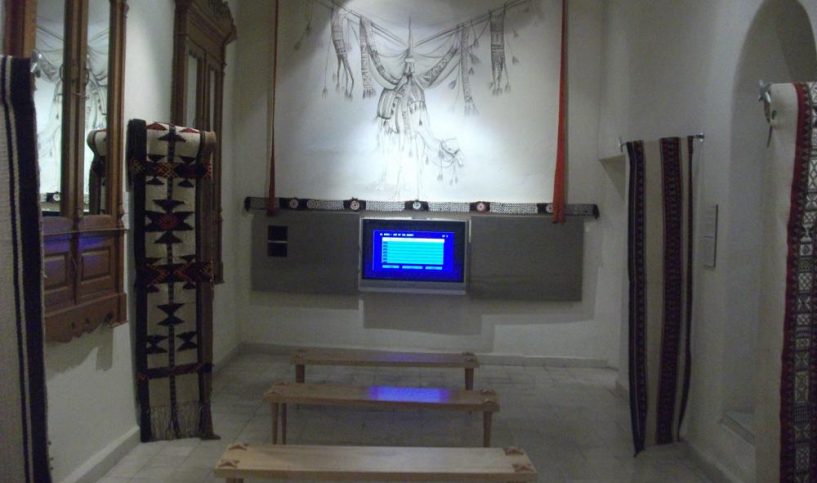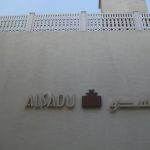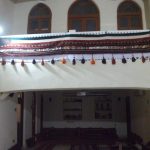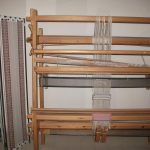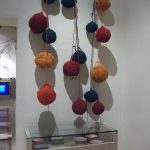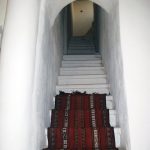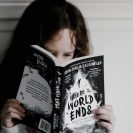by Christopher Hockey
Last month’s visit to Kuwait National Museum failed to impress or shed light on the true meaning of Kuwaiti national identity (bazaar June 2012). This month, the third museum review, focuses on Sadu House. Could a much smaller, more specialised museum do a better job? Sadu House is dedicated to preserving the traditions of Bedouin Weaving. Perhaps textiles hold the key to Kuwaiti identity? I visited the museum with a special eye on this question.
What is the Museum?
The galleries are spread throughout a beautiful traditional Kuwaiti house (Beit Al-Sadu) in the City. As you stand at the entrance to the building, it is immediately obvious that this is a well organised, professionally run establishment. The displays consist of a wide variety of beautifully crafted Bedouin textiles and the equipment used to make them. Unlike the National Museum, there are explanations aplenty, which include both technical commentaries and explanations of how the items were utilised. There is a lot of information about the dyes, spindles, looms that the Bedouins used. The museum is focussed and the displays are clear about how this tradecraft fits into Kuwaiti history. The layout of the museum is a little confusing but that is only due to the nature of the house’s architecture. There is a room focusing on Bisht (cloak) production and embroidery, rooms that focus on various weaving techniques and structures and rooms that concentrate on equipment.
The ALSADU project runs as a cooperative owned by currently active weavers. There is an acceptance of change and a celebration of the more modern weaving techniques. Indeed the project aims not only to preserve but also to improve the weaving tradition and its methods. The displays show how desert weaving has been integrated into urban life today and how the social role of the weavers has had to adapt. Weavers have had to find a new niche within the market economy. Their work now has to be sold commercially and the weavers must use imported materials and ideas.
Al-Sadu is the Bedouin term for weaving and for the loom. Weaving was the main expression of Bedouin art and the museum attributes an almost mythical, poetic value to the work. To the Bedouins, there were two sides to the industry. Weavers were needed to create functional items (tents, tent dividers, bags and rugs) with different techniques used for different items but they also were essentially artists. In what was otherwise a simple and practical lifestyle, weavers provided luxury. They created aesthetically beautiful patterns that were important to tribal identity. The patterns (executed from memory) in the fabric identify desert animals and plants. They reflect symmetry, rhythm and harmony. Sadu House is committed to understanding and documenting the meanings behind these patterns. The weavers would use horse, camel, sheep and goat hair and until recently all the dyes used were from natural plants found in the desert. Few of the oldest textiles still exist because the Bedouin would discard and replace old items. The museum however does house pieces from the late Nineteenth Century. The floor loom that was used could be rolled up with a half completed textile attached and carried around. This meant it was well suited to the nomadic lifestyle.
The museum, and its associated cooperative, plays an important role in the community. Sadu House is used as a headquarters for the Kuwait Textiles Arts Association (KTAA). Both the KTAA and Sadu House itself offer frequent lectures, exhibitions and craft fairs. Workshops are also offered for both children and adults. These include classes taught by Kuwaiti ‘master weavers’ on how to use the ground loom and are offered to beginners as well as those with experience.
Overall visitor experience
The museum is classy, clean and smart. There are enough exhibits to maintain the visitor’s interest but not so many that the intrinsic value is lost. The significance and purpose of every piece (both textiles and tools of the trade) is made very clear. There is also a small library and a video room. Whilst the film is a little outdated, it remains a very informative explanation of the aims of Sadu House and the importance of weaving to Kuwait. Near the entrance there is a gift shop where you can purchase traditional works, with the proceeds going to the weavers who are part of the co-operative. Opposite this, a small cafe offers coffee and cake. These basic customer amenities make for a well-rounded visit but there could perhaps be a guide or a reception desk to welcome you on arrival. Overall the museum would interest both textile enthusiasts and the more casual visitor.
What does it say about Kuwaiti national identity?
As important as textiles and the processes of weaving were to Kuwait’s past, in themselves they cannot represent Kuwait as a nation. However, the way this museum preserves Bedouin traditions and teaches about weaving as an art form encourages the visitor to engage with their past. It shows how hard work and skill were important aspects of life as a Bedouin, how people took pride in their work and how much meaning they attributed to everyday items such as clothing. The museums acceptance of change is refreshing; it shows that modernisation does not have to be a bad thing- tradition and heritage can find an important niche in modern urbanised society. The museum sends a very clear message: that Kuwait has a rich cultural past hidden in the Bedouin way of life.
For more information on current classes and exhibitions follow Sadu House on Facebook or Twitter, @SaduHouse, and visit the KTAA website kuwaittextilearts.org.
Sadu House is located in front of Kuwait National Museum, close to the National Library. The building is located on the corner of the Gulf Road and the street used to access the National Museum. The museum is open Sunday to Thursday 08.00 to 13.00 and 16.00 to 20.00.

